The first time I spoke with Kleber Mendonça Filho was when I was introduced to him and producer Emilie Lesclaux by Jytte Jensen at the Museum of Modern Art in 2012 after he presented Neighbouring Sounds (O Som Ao Redor) during New Directors/New Films. Over the years we continued to stay in touch, meeting up for conversations on Aquarius (a highlight in the Main Slate of the 54th New York Film Festival), starring Sônia Braga and in 2019 for Cannes Film Festival Jury Prize winner Bacurau, co-directed with Juliano Dornelles (a highlight in the Main Slate of the 57th New York Film Festival).
 |
| Pictures Of Ghosts producer Emilie Lesclaux and Kleber Mendonça Filho with Anne-Katrin Titze in the sculpture garden of the Museum of Modern Art in New York. Photo: Jytte Jensen |
For Pictures Of Ghosts (Retratos Fantasmas, Brazil’s Oscar submission and a highlight in the Main Slate of the 61st New York Film Festival) Kleber and I met on Zoom to discuss the impact films by Agnès Varda, Manoel de Oliveira, and Martin Scorsese had on his documentary; guardian angels Tony Curtis, Janet Leigh and a Psycho poster; Vera-Ellen and Gene Kelly in the Slaughter On 10th Avenue dance choreographed by George Balanchine in Norman Taurog’s Words and Music and a carnival sequence; UFA cinema history, and the movie palaces past and present of Recife.
Cinema is the medium of ghosts. And cinemas were the places where they could get in touch with us. Now that technology made sure that the ghosts could also enter our homes and even our pockets to follow us around wherever we go, many of the old movie palaces, their former homes, have become superfluous and were turned into something else - a supermarket, an evangelical church, a gym.
Pictures of Ghosts transports us to Recife, the director’s hometown, the capital of Pernambuco, Brazil and unravels the history of its big cinemas - those gone and those still standing strong, what was and what has become. But before that, he takes us home to the apartment where he lived on and off for 40 years. We see old photographs and moving images of family life and film life, how his mother remodelled the place, how his brother Múcio, an architect, added an Oscar Niemeyer touch to the roof terrace, and as the uncanny kernel of the film, the picture of a “real ghost.”
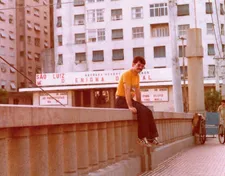 |
| Kleber Mendonça Filho: “Cinema of course is magic. But cinema is also a product. And these buildings, they are machines built to sell movies.” |
Part II drops us off downtown, where all the spectacular cinemas were located, drawing in the masses during the second half of the 20th century. Kleber’s soothing voice-over explains the changes the city has seen. And there is always the same bridge, over decades, that allowed you to see the marquees of the movie theatres, announcing which ghosts would be dwelling there for the next week.
Chapter III explores ghosts and holy ghosts. Two cinemas reopened as evangelical churches with no changes made to the décor. Others became, or stayed, commercial cinemas providing blockbusters, which were not only big American action fare, but also Bruno Barreto’s 1976 hit Dona Flor And Her Two Husbands with Sônia Braga, who would later star in Kleber’s Aquarius and shine in his Bacurau.
Pictures Of Ghosts ends on a lovely note, with Kleber in the back seat of an Uber, which feels a bit like a stage coach, as he rides through the nightly city while chatting with the driver whose special powers are enhanced by listening to Herb Alpert’s Rise.
Anne-Katrin Titze: Kleber, good to see you again after last night!
Kleber Mendonça Filho: Good to see you!
AKT: We talked over ten years ago about former cinemas and the remnants of cinemas!
KMF: I remember! I remember! We talked about a car park, I think, in New York City.
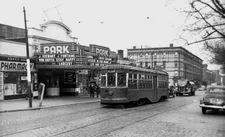 |
| Brooklyn’s Park Theatre (1915 - 1965) |
AKT: And a supermarket! The cinema-past of places that can never be fully erased. And here is your film about the subject, which is really beautiful!
KMF: Thank you! I’m very happy with that film. And the reactions are good.
AKT: One of the things you show is that the history of cinema is also the history of buildings.
KMF: Yeah. We tend to have a romantic notion of cinema and I’m all for that. Filmgoing is part of my life, it’s part of your life. But at some point I began to look at cinemas almost like shop windows for an industry. They are like shops where they sell products and the products are films. And that has been very clear for me since the Nineties.
I spent a lot of time in two of those movie palaces that are actually featured in Pictures Of Ghosts. I could see how the whole system worked. It was all about getting the product, getting the prints, taking care of the product, taking care of the prints, and putting them into the projector and programming it. Making sure the place was clean and the posters were properly displayed and of course the money coming in. And the security company coming in to get the money.
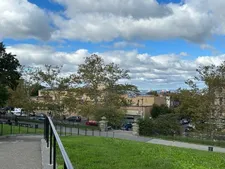 |
| Park Theatre is now a supermarket Photo: Anne-Katrin Titze |
The whole operation was very clear and it kind of de-romanticised a lot of what I had felt up to then in terms of what cinema is. Cinema of course is magic. But cinema is also a product. And these buildings, they are machines built to sell movies. If you want to get poetic you can say they are made to sell dreams. But each dream has a ticket price. And I have slowly built this notion of what a cinema, a movie theatre is.
AKT: You have the great line in the film, that it is like “being on a ship prepping to be sunk.”
KMF: Yes, that’s how I felt.
AKT: I mean, it is this big ocean liner from the 1940s, that is both physical and also has all those dreams and ghosts in it.
KMF: I was 20 years old at the time and maybe today, because of the discoveries I just told you about, about the cinema itself … But at 20 I thought it was really sad that such a beautiful place was being prepped to be destroyed. But that’s just how it was and that’s how things came to be. It did not make sense from a business point of view anymore. It was built in the late Thirties and it had run its course.
AKT: You give us a background story of the manager being German and that it was an UFA theatre. Did you know any of this beforehand?
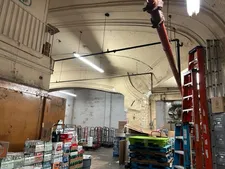 |
| Inside the former Park Theatre Photo: Anne-Katrin Titze |
KMF: No, no, no! I discovered that during research for Pictures Of Ghosts because I contacted Abilio Guerra. He’s an important researcher on Rino Levi, the architect. And I asked him if he had pictures that I had never seen of the Palace and the Trianon cinemas. And he says, yeah sure, I can send you a full dossier on Rino’s projects for the Art Palácios in Recife. When the dossier came, I opened it and I saw all the special drawings for the UFA cinema. And I said “ so Art Palácio was an UFA cinema? UFA, as in Goebbels and Hitler?”
AKT: Indeed!
KMF: And then it finally made sense, because my good friend, Alexandre Moura, the projectionist, had mentioned many times that when he first came to the Art Palácio in the Forties, the cinema had a German manager. And I thought why would the Art Palácio have a German manager? And everything suddenly made sense. I remembered the cinemas I went to in Berlin for the Berlinale - the Zoo Palast. Palast is a recurring word in German for these cinemas, so the Art Palácio - it all made sense. It was a completely German project.
AKT: With a Jewish architect!
KMF: Sure! Built by a Jewish architect!
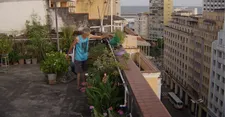 |
| Kleber Mendonça Filho on Pictures Of Ghosts: “Most of this film happened in the editing.” |
AKT: In the film there is a line about your apartment - to continue with architecture - that what used to be the maid’s room, became the place where the family watched films. History changes the function of architecture and films show this to us. You have it in Mr. Blandings Builds His Dream House [directed by Henry C. Potter, starring Cary Grant and Myrna Loy], for instance, where the apartment becomes too small, as does the maid’s room, and the family has to move out of the city. Changes in our lives shown in cinema are fascinating.
KMF: Yes, I realised I wanted to use the apartment in the film late, not late, but during the editing stage of this film. Well, most of this film happened in the editing. I had originally begun the film in downtown, showing the cinemas, but at some point it felt boring. And it felt like a catalogue of movie palaces. I was afraid that somebody would watch and say, so is it going to be in alphabetical order? How does that work?
And then I realised that I should go into my house. But it shouldn’t be about myself, it should be about the place. And what my family did to the place, what my mom did to the place. Because once I establish those changes in the apartment I can also establish the changes to the city and to the public space. And to the public space through the cinemas, which were places of congregation. So that somehow it makes sense, somehow it might make sense.
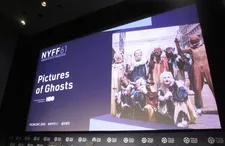 |
| Pictures Of Ghosts at the Walter Reade Theater Photo: Anne-Katrin Titze |
AKT: Oh it makes perfect sense. Because it also connects to your cinema, your films. The sequence about Nico, the dog is very funny, how you set that up. There is the “picture of the real ghost” and then you say you heard the dead dog … I’m not giving it away here, but it’s beautifully presented by you!
KMF: Good!
AKT: I noticed that you show a lot of the ornate sidewalks outside the cinemas. It’s very lovely, because the cinemas throw us out after the movie is over, into the world. We are back in another reality. But there’s the sidewalk and we are still walking a little bit as though we’re in that other world.
KMF: Yes, it’s an ornate sidewalk, which kind of continues a little bit. I mean it works both ways. As you leave the cinema you’re still walking on the cinema. And if you’re coming to the cinema, you step onto the sidewalk and you go “I am now in the cinema.” To this day I remember the physical feeling of - as I approach the cinema, that particular cinema - I would feel a change in temperature from the air conditioning coming out into the pavement, the sidewalk. And also the smell of popcorn. All of that just gave you this strange suggestion that you were coming onto fantasy in a way.
AKT: Your hometown is known for its carnival and you show sequences of street performance. With one of them I was reminded of a movie scene, of course, namely Slaughter On 10th Avenue. The Balanchine ballet choreographed to Richard Rodgers music and I believe it’s Gene Kelly and Vera-Ellen dancing. There’s a fake fight sequence and people are wearing striped marinière tops.
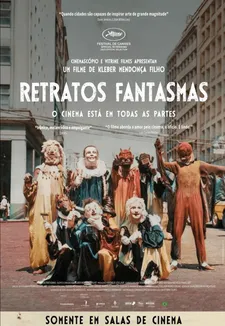 |
| Retratos Fantasmas poster |
KMF: That’s beautiful!
AKT: I was wondering if they maybe share an old tradition?
KMF: No - but that’s beautiful. Massacre On what?
AKT: It’s called Slaughter On 10th Avenue.
KMF: Slaughter On 10th Avenue - I have to look that up! The carnival troupe, Escuta Levino e os Guerreiros do Passo, which you see in the film, they perform every Thursday night before carnival and they wear costumes from the 1940s and they go back to what carnival used to be in the 1940s. I really love that segment in the film. I love the sound in that segment. And I love the logic of it. The guys were throwing capoeira - at the time, because of the incredibly racist Brazilian society.
In the Forties Brazil was still very much a racist country but in the Forties the police would not even allow people to do a capoeira on the street. Because it was “a slave thing.” They would actually use the terrible racial slur. So they are throwing the capoeira and when the policeman arrives, they subtly change the capoeira movements into the frevo movements, which is the accepted dance moves for carnival. So that is a much discussed sequence in Brazil, because it hits people very hard. They’re very moved by them. And some of them don’t even understand that that is a performance. They actually think it’s a scene from carnival. It’s beautiful that you have mentioned Slaughter On …
AKT: … 10th Avenue.
KMF: I got to look it up.
AKT: You mentioned yesterday before the screening, because of the Agnès Varda - Pasolini short screened before, that you had some unexpected invisible helpers on your film. I don’t know if those were the words you used.
KMF: Imaginary friends!
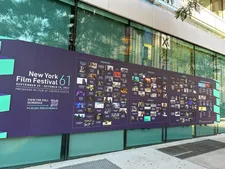 |
| New York Film Festival 61 at Lincoln Center Photo: Anne-Katrin Titze |
AKT: Imaginary friends, like Agnès Varda! Who were the others? Were there others?
KMF: Oh many! It happens in every film. It probably happens to you when you’re writing. Sometimes just an imaginary friend comes along to help you. Agnès Varda was definitely one of them. She has a beautiful film - I think in English it’s called Along The Coast [Du Côté De La Côte]. It’s a short film commissioned by the Ministry of Tourism, of all places, in France. And she made a beautiful film about the Côte d’Azur. I mean it’s completely different from Pictures Of Ghosts but it put me in the mood somehow.
Manoel de Oliveira, the Portuguese filmmaker, he made two beautiful films, one is about his house. It was supposed to be his last film in 1982 but it was only seen after he died, posthumously. It’s a beautiful film. Another film of his is called The Porto Of My Childhood. Those were two films. I also thought of Scorsese’s Italianamerican about his parents and the sauce for the spaghetti. I think it’s a beautiful film about his house and his parents. So these are films that come to mind when you’re making the film. They help you not go crazy when you begin to doubt whatever it is that you’re doing.
AKT: And then you got two guardian angels for your film - Janet Leigh and Tony Curtis, of all people.
KMF: Oh yeah, I love it! The image on the beach is like 250 meters from where I used to live! And the other coincidence is that twice you can see in my house the poster for Psycho and you can see Janet Leigh prominently featured! Never planned! Because I only found the footage two years ago of them on the beach.
AKT: Have a great screening tonight! It’s really wonderful, I love the film!
KMF: Thank you very much! It’s great talking to you again!






















